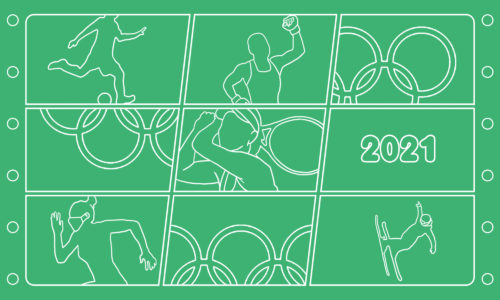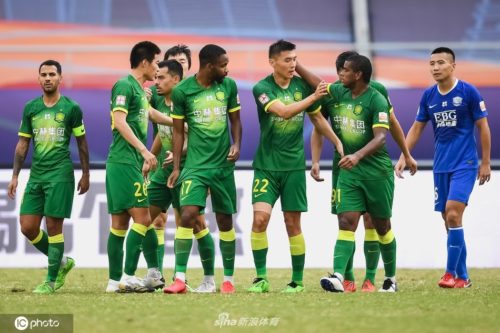Pro wrestling in China is ready for its comeback
The short but eventful history of China wrestling is filled with highs and lows. For a while, rival promoters dreamed of building the WWE of China, but money dried out and then COVID nearly killed the industry. Those who are still kicking — a motley crew of professionals, hobbyists, lifers, dreamers, and realists — are now working together to rebuild this thing they love.
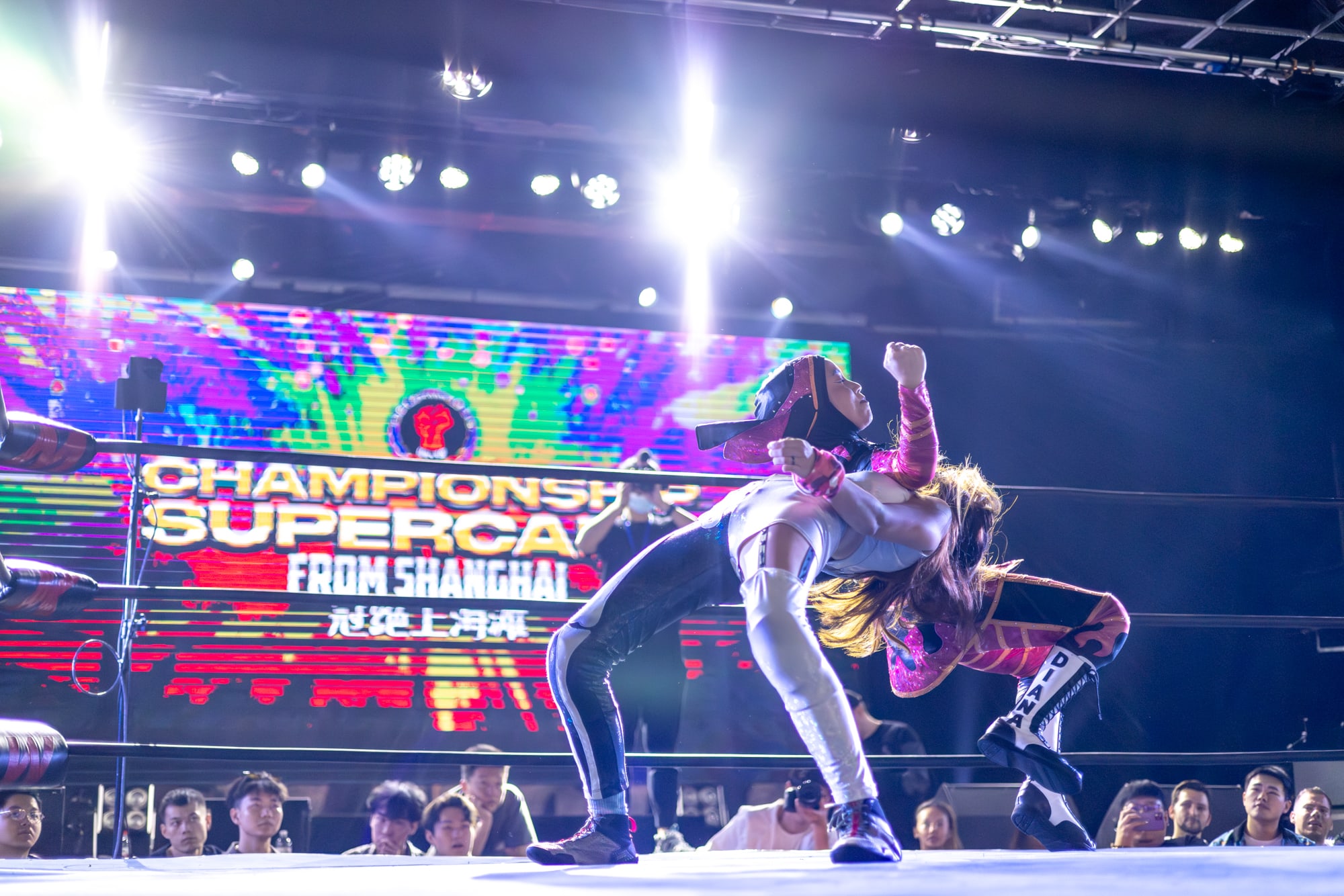
A nervous energy ripples through the venue in the hours before showtime at the MKW Championship Supercard from Shanghai. This is Middle Kingdom Wrestling’s first major event since China lifted its zero-COVID policy in December, and questions abound: Would old fans still be interested? Could new ones be made? There is also a maddening pent-up anticipation: Originally scheduled for last summer, the show was postponed when COVID lockdowns crippled Shanghai, and then postponed again in September due to more outbreaks. This night, June 6, has been a long time coming.
Wrestlers have gathered from across China, Japan, Southeast Asia, and whereabouts unknown. Zombie Dragon, MKW’s first trainer, finalizes details with several performers in the lead-up. Big Sam inspects the ring. Yoshi Tatsu watches and nods. Others help tighten the turnbuckles. Alexis Lee and Nor Diana chat near the timekeeper’s area. This is the calm before the storm, before the makeup and costumes go on and a ragtag band of Chinese and international wrestling amateurs, professionals, hobbyists, and lifers make a collective transformation into superheroes and villains.
Will the audience “get it”? That’s been on the minds of organizers. In the best wrestling matches, stories are told in the ring, whether of underdogs triumphing against the odds or scoundrels breaking hearts, making little kids cry; the “smarter” a crowd, the more subtlety the performers can incorporate, and the more complex the stories can become. This is the art of professional wrestling, achieved through something called “ring psychology,” but it requires an audience willing to suspend disbelief and let themselves be immersed in the performance, even play a part in it.
The jury’s out on this packed Shanghai house of more than 300. Things don’t get off to the smoothest start when the emcee confuses the stakes of the first match. A Guangdong wrestler named M.A. (朱江 Zhū Jiāng) — who saunters to the ring in Kansas City Chiefs regalia — beats Shaukat for the chance to challenge for any championship at a time of his choosing (think Money in the Bank briefcase). The crowd watches politely.
But things are only heating up. During a tag team contest between C2NY and Bad Boys, fans chant, “Let’s go, Buffa,” while — even half a world away, conditioned by years of WWE audiences screaming at John Cena — others reply, “Buffa sucks!”
Midway through, everyone hushes: Buffa and his opponent, Zhào Jùnjié 赵俊杰, engage in a strong-style exchange, with Zhao knife-edge chopping Buffa in the chest and Buffa swinging an elbow into Zhao’s jaw. They do this repeatedly.
The elbows are stiff. Purposefully stiff.
Very stiff.
Zhao’s neck turns red, then purple, drawing oohs and ahhs from the crowd, then murmurs. You can almost hear people wondering, “What’s going on?” Zhao chops, Buffa cranks. The smacks resonate through the venue.
During a later match, one of the ring girls in the VIP section offhandedly remarks about the in-ring action, “Too fake.”
Zhao and his tag team partner, Wāng Xīnxuān 汪鑫轩, are standing nearby and overhear this. Wang points to Zhao’s neck, which is discolored and swollen. “Does that look fake?”
The girl doesn’t reply.

The theatrical art of professional wrestling is as American as they come, rewarding the big, brash, and braggadocios. It is full of imagination and storytelling, deploying simulated violence as the vehicle for a morality play that holds a mirror to society’s virtues and vices. Its history can be traced to the early 20th century, when wrestlers realized that fixing their matches was safer, more enjoyable to watch, and more lucrative. It had its carnie days, then its cutthroat capitalistic ones, when Vince McMahon bought out rivals until his company — World Wrestling Federation at the time, now World Wrestling Entertainment (WWE) — came to be synonymous with the industry.
How in the world did this thing get into China?
It’s a love story, almost everywhere you look. For Chinese like Ryan Chen (陈虾仁 Chén Xiārén), the founder of a Guangzhou-based promotion, it’s about watching the WWE as an early teen and falling in love with the pomp and pageantry. For expats like Adrian Gomez, the love story extends to China, which gave him the opportunity to start Middle Kingdom Wrestling.
And for people like Liú Xuànzhèng 刘炫正 — whom English and Chinese speakers simply call The Slam — it’s about the physical poetry.
Liu learned about wrestling through the Japanese video game Shin Nihon Pro Wrestling Toukon Retsuden, then became smitten by it through watching WWE, particularly The Undertaker. This was in 1998. In 2002, he traveled to South Korea to train with the now-defunct World Wrestling Association (WWA), and when he returned home to Dongguan in southern China’s Guangdong Province a year later, he built a wrestling ring in his backyard and advertised it as a “wrestling gym.”
“I was a wrestling superfan when I returned from Korea,” The Slam tells me. “All I wanted was to wrestle. But if there’s no promotion, the only thing you can do is create your own.”
So he did. He founded China Wrestling Entertainment (CWE) in 2004, which held free shows at bars and malls, sometimes in front of tens of people. The CWE was never financially viable, but it put wrestling on the map in China. It allowed other Chinese wrestling enthusiasts their first glimpse of the possibility that this industry — this exotic, foreign, larger-than-life thing — could be part of their life.
One of those enthusiasts was Wong Yuk Lun, better known by his ring name, Ho Ho Lun (何顥麟 Hé Hàolín). Before he became The Slam’s most accomplished pupil — winning a match in the WWE’s Cruiserweight Championship in 2016 and spending two years in WWE’s developmental system, and now signed to Dragongate Japan Pro-Wrestling — Ho was a wrestling junkie. Growing up in Hong Kong, he consumed all the wrestling content he could, and sold VCDs and action figures at flea markets in Victoria Park.
He was 18 years old when he saw, on QQ Messenger, a posting about actually doing wrestling. Ho messaged the guy in charge.
“Are you in Dongguan?” The Slam asked.
And the follow-up question that would change Ho’s life: “Do you want to come?”
Ho trained with The Slam for four years before buying a ring in Hong Kong and starting his own promotion, the Hong Kong Wrestling Federation (HKWF), which he ran until the pandemic, when he let his friend and protégé, Bitman (贤必文 Xián Bìwén), take over.
“When we started, Chinese internet fans would say, ‘Oh, you guys are pretending to be wrestlers, you’re so skinny you can’t be wrestlers,’” says Ho, who is 36 but has retained his boyish looks and charms. “Now they see our determination to keep doing this, and they’ve become more supportive.
“But it’s a step-by-step process. You’re not going to get thousands to come to your first show. That’s impossible. It’s going to be a long time before we can run a 3,000-person show.”
Ho’s teacher, The Slam, knows this well. Nearly 20 years after starting — and now widely known as “the first-ever wrestler in China” — he’s still putting in the steps. His physical appearance hasn’t much changed: He has round shoulders and a round head, the kind of physique best drawn with a broad brush. He’s not the biggest or most muscular, but his intensity flares from across the room.
“Why continue doing it?” he says, sitting with me backstage. “Because of the people’s enthusiasm. Because of my students. And because of the fans. They all supported it, they liked it, and I liked it. When I no longer want to do it, fate always calls me out to do it.”
It’s at this time that his name is called out over the intercom — not by fate, but by Adrian Gomez, who needs him for final walkthroughs.

Indie wrestling shows are often held in auditoriums or gyms, which can feel impersonal, but the setup at MAO Livehouse in Shanghai gives the MKW Championship Supercard both cozy and big-time vibes. There is a proper stage from which wrestlers appear and a floor-to-ceiling screen for entrance videos. The acoustics are great: Slaps are crisp, and Gomez mics up the ring extra loud so that bumps reverberate.
The boys are prepping, in their own ways. Wáng Tāo 王涛, a rising star who is only 21, scrolls through his phone while Coldray (a literal translation of his Chinese ring name, Hánguāng 寒光) rests on an adjacent couch, his MKW World Championship belt next to him underneath a red fur cloak. Chén Wénbīn 陈文彬, Gāo Yuán 高原 (a.k.a. Insolent Devil), Aegon, Plata Mascaras (Wade Massen), and Sunny Zhai go over their fatal five-way. Chinese wrestling mainstay Ash Silva chills.
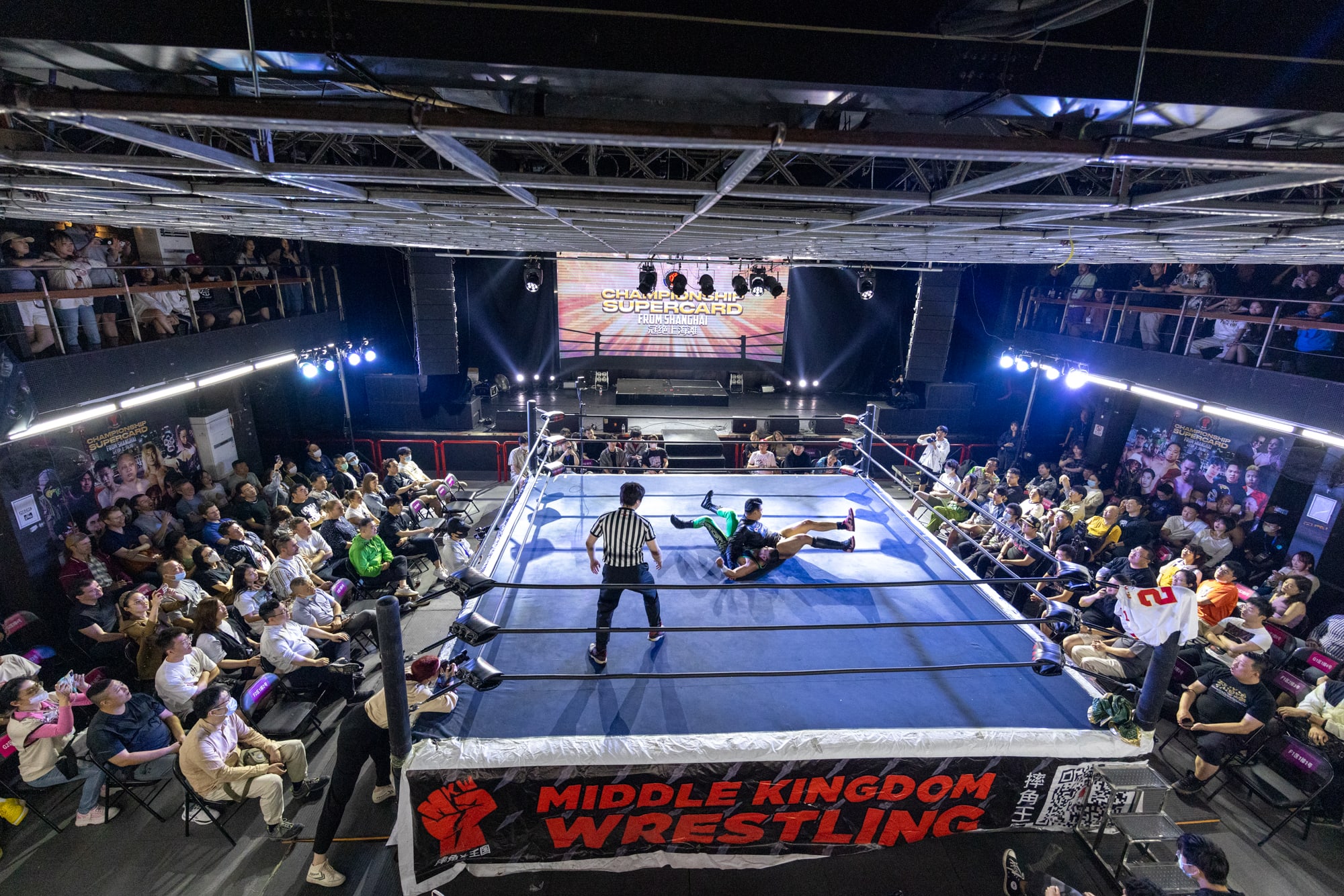


In the hallway and many more times in his head, Kyle “Kyote” Rozewski, an MMA fighter set to make his wrestling debut, visualizes his sequences. One, two, three, four, he counts, pantomiming the moves with each number: Waist lock, hip toss, choke, reversal. His opponent will be the ironically named Little Johnny, the six-foot-seven-inch, 330-pound Luis Campos.
“When I left Argentina, I didn’t think I was going to wrestle ever again…but China is where I’ve had my most matches,” Campos says. This will be his final show in China, and it promises to be bittersweet; he will make three separate appearances on this night, but not long afterward will head home to California, and eventually end up in Germany to pursue a second master’s degree.
Little Johnny is a glowering heel, but Campos is soft-spoken and intelligent, and has many thoughts on the future of Chinese wrestling. “There’s this threshold that needs to be broken,” he says. “I remember it was all of a sudden that hip-hop became so popular [in China] that every mall had a hip-hop store and all my friends were taking hip-hop classes out of nowhere, all because there was a TV show. Right? Then, for a while, it was oratory: People were giving speeches all of a sudden because there was a speech competition show.” Campos lists skiing and Ultimate Frisbee as two other examples of activities that went from obscure to mainstream seemingly overnight in China. “I think Chinese, especially Shanghai audiences, are very trend forward. They like to seek trends and go for the next thing. So, it could be possible that we have a big boom in Chinese wrestling and it becomes very cosmopolitan.”
Little Johnny enters the ring sporting thick dreads and a gnarly mask, plus a well-worn look of disdain for the universe. Rozewski comes out all smiles and excitement. “In wrestling, it’s all about the moments,” trainer Zombie Dragon had told Rozewski the day before. “Give it some time.” But adrenaline is one hell of a kick. Once the match starts, things speed up. Near the end, there’s a spot with Rozewski on the top turnbuckle, then on Little Johnny’s shoulders, trying to lock in a triangle; he momentarily loses his grip due to the sweat and bangs his head on the mat. He still manages to roll Little Johnny over and win with a triangle choke, and is awarded the inaugural MKW Jade Warrior Championship.
Rozewski isn’t in a celebratory mood in the back. “Feeling all right, but my head hurts,” he says. The competitor in him kicks in as he critically analyzes his performance. “I don’t think I connected with the crowd as much as I could have. I could feel that halfway through. That’s not their fault, that’s my fault. I’m a bit disappointed in that regard.” He’s off to the U.S. in August to have his 84th and final MMA fight, and then will return to Shanghai to run his gym, Animal MMA, and train for more wrestling. After all, he has a title to defend.
“We can build a whole world under one match. That is so cool,” he says. “We’re all authors and we get to explore the boundaries of our imaginations, then put it in reality. It makes me feel like a fucking superhero.”

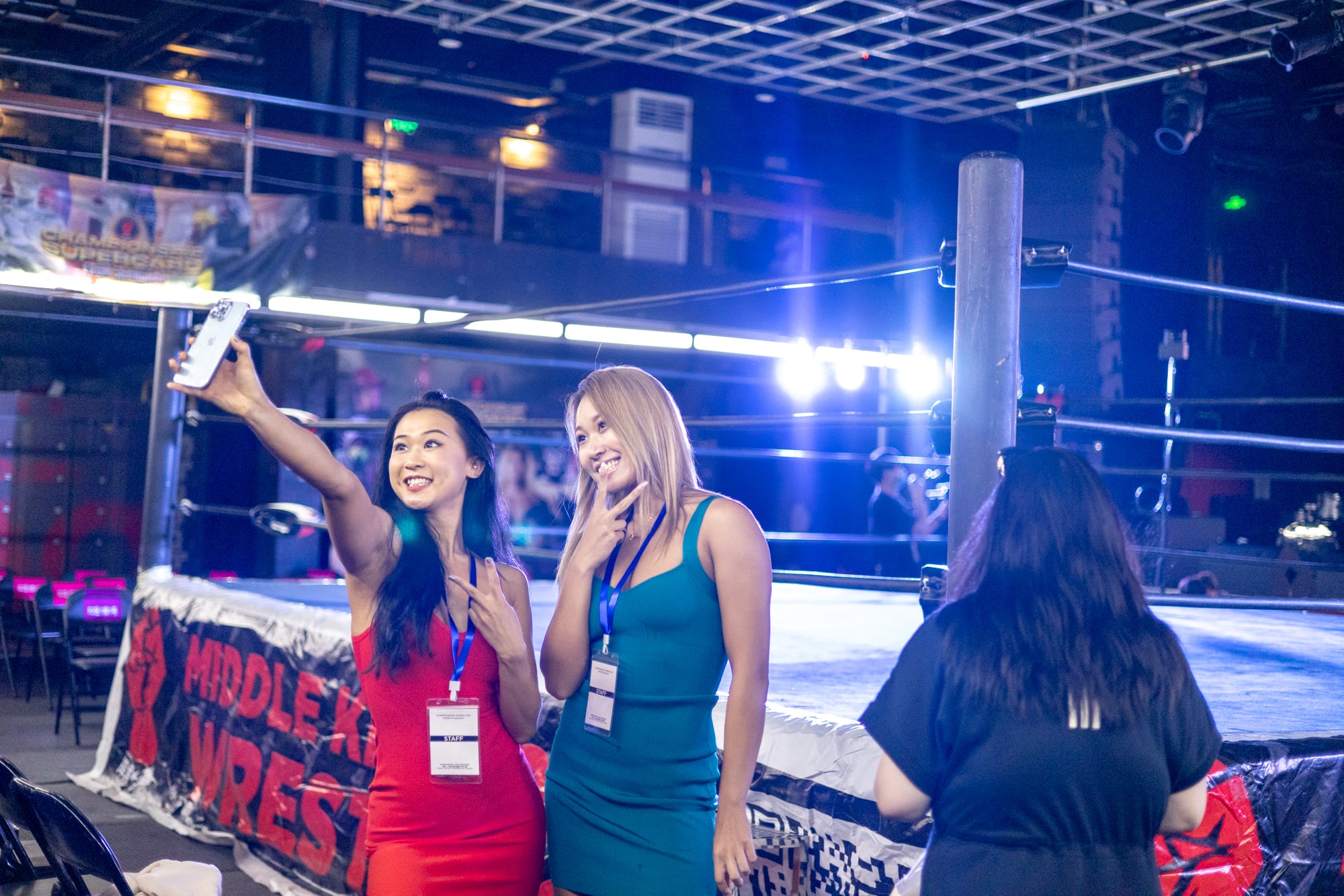


Before there was pro wrestling in China, there was the WWE. And for a while, the WWE really pushed the China market.
The Ringer wrote about the company’s “vast untapped business potential in China” in 2016. The New York Times reported on the WWE’s business ventures, including a partnership with Chinese video service PPTV to stream the company’s weekly shows. That year, the WWE signed its first batch of mainland Chinese wrestlers, headlined by Wáng Bīn 王彬 — ring name Tian Bing — who was marketed as the face of Chinese wrestling. He made his debut in Shanghai that September, defeating Bo Dallas and pumping his fists upward, upward — the direction wrestling was seemingly trending in this “vast untapped” market. Two years later, even Chinese state media Xinhua had nice things to say: “If WWE can find a way to keep eliciting that reaction, their China business will always be in good shape.”
The size of the China market has always been an allure for foreign businesses, dating back nearly a century. For WWE executive chairman Vince McMahon, who has historically been obsessed with size (the WWE is known as the land of giants, where the bigger the wrestler, the better), China must have seemed like a metaphorical Andre the Giant. In actuality, it was more Giant Gonzales, and WWE’s foray into the market sputtered.
For one, Tian Bing’s WWE career never panned out; he was released in 2018 and has only sporadically been sighted at Chinese wrestling events ever since. But a bigger problem is the Chinese level of wrestling comprehension. Just as an example: The Chinese translation for pro wrestling — shuāijiǎo 摔角 — is a neologism, because the direct translation for wrestling is actually the homograph shuāijiāo 摔跤. It’s a small but significant difference, signaling to viewers that the latter is a sport while the former is…something else. Translating that “something else” for the Chinese audience has been tricky. In the past, some shows have had the emcee explain to audiences that what they’re about to see is choreographed — “fake” — and stagehands may even get in the ring to demonstrate the various ways a match can end (via pinfall, submission, etc.).
The WWE currently has a Chinese wrestler on its main roster, Xia Li (real name 赵霞 Zhào Xià), who was signed in 2017 from a Shanghai tryout, but she hasn’t moved the needle back home. No amount of promotion or gimmickry — such as John Cena speaking Mandarin, however impressive — can easily narrow the gap in understanding, especially considering the scarcity of actual pro wrestling events in China. There hasn’t been a large arena show in the country since 2019, when the WWE was last in Shanghai. (The company ran its first show in China in 2010 as part of the Shanghai Expo.) And then there is this old indie complaint: China may have its share of WWE fans — the company licenses content on streaming platforms iQiyi, Tencent Video, and Migu — but they aren’t necessarily fans of wrestling.
All that said, there was a stretch during the mid-2010s when it was possible to believe that wrestling could flourish here, as multiple investors simultaneously — and dramatically — reached for the brass rings.
Paul Wang founded China Nation Wide Wrestling Entertainment (CNWWE) in 2013 and convinced wrestlers like The Slam to move to Chongqing to work for him full time. Fèi Wǔxīng 费武星 founded the Chinese Wrestling Federation (CWF) in 2015. Fù Huáyáng 傅华阳 founded Oriental Wrestling Entertainment (OWE) in 2017 with considerable financial support, reportedly raising $10 million, which enabled it to hire Dragongate’s Cima (Nobuhiko Oshima) as head trainer, partner with All-Elite Wrestling (AEW) and Las Vegas’s Future Stars of Wrestling, and air made-for-TV shows with elaborate stage setups and multiple cameras — and, occasionally, girl bands. “We spent money like crazy,” OWE’s vice president told Sixth Tone.
CNWWE failed multiple times, CWF ran out of steam, and OWE was hated out of existence. The promoters had money and ideas, but they didn’t fully get the business of pro wrestling.
One person who did get it, though, was Adrian Gomez. Growing up in Phoenix, he learned about wrestling, much like The Slam, through a video game. When he finally saw the real thing on TV, “It just blew my mind, and I became obsessed,” he says. He volunteered to work wrestling shows in Austin, Texas, as part of Anarchy Championship Wrestling (ACW), and tried all the roles, from cameraman to ring announcer to chauffeur.
At the Championship Supercard from Shanghai, Gomez sports an oversized black suit that makes him look like a perfect on-screen wrestling authority figure, but he prefers staying in the background, doing everything except getting in the ring. He founded MKW in 2015 and has done well enough to make a living from it, with two full-time staff and a handful of part-timers.
“I’m most looking forward to everybody being able to see the potential of Chinese wrestling again,” Gomez told me on the phone two days prior in Harbin, 1,000 miles north of Shanghai, where MKW is based. “And that this event can bring back some of the momentum Chinese wrestling lost during the height of COVID zero. And that it can put Chinese wrestling back in the conversation with not just fans, but also industry people. That this is really a landmark moment for wrestling in China.”


It’s hard to overstate the impact the pandemic had on Chinese wrestling. Everyone talks about this period with the same rueful tone, filled with sighs. “It was depressing for a while, man, because we were really growing up,” says Zombie Dragon, who moved from Atlanta to Harbin to be MKW’s head trainer (a position he handed to Coldray when MKW’s training center shifted from Harbin to Shanghai during the pandemic). “We had the school, we had the students, we had the reputation, we had the other companies they could go to. It was doing good.
“COVID destroyed so much. It destroyed companies. It destroyed a lot of my guys’ confidence. I lived near the gym, within walking distance. We couldn’t even go to the gym to train the guys. It really hurt us, man.”
MKW tried to make the best of it. Gomez filmed a studio show, MKW Blast-Off, that was distributed on Chinese video-streaming sites over two seasons. It didn’t draw a huge following, but it provided work — and IMDB credits — for lots of people during a difficult time.
One other mainland Chinese wrestling company survived: King of Pro Wrestling (KOPW), led by Ryan Chen.
Chen was 11 years old when the wrestlers of the Attitude Era “infected” him with a love for wrestling. He didn’t have the brawn to wrestle, but he had brains. A businessman by training, he got to know Fei Wuxing, who made him the CEO of Shuaijiao.com (now Shuaijiao.cn), the No. 1 Chinese website for all things wrestling. Chen would organize teams of translators to subtitle WWE shows and upload them — somewhat cheekily, Chen admits, considering the website never had permission to do this. But he did obtain permission to sell official WWE merchandise, and in 2012, WWE invited him to Miami to attend its Business Partner Summit as well as Wrestlemania.
“This was my first time seeing how this [wrestling] culture could impact an entire city, lift an entire economy,” Chen says. “It really could attract people from around the world. After I experienced this live, I carried some deep impressions back to China, and I felt even more sure that I had to do this.”
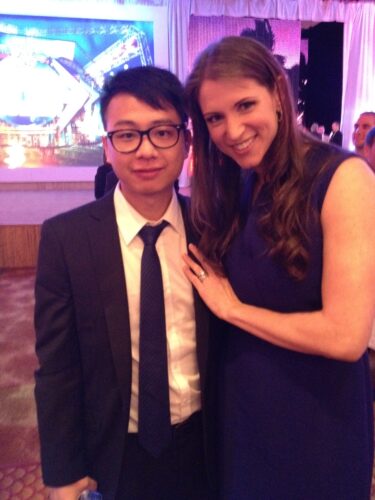
Chen created KOPW in 2018 and immediately tried to make a splash, inviting performers such as Zack Gibson, James Drake, and Sam Gradwell, all then signed with WWE’s NXT UK. Emi Sakura and Riho — AEW’s first women’s world champion — both stepped through KOPW ropes. Their appearance fees, plus travel and accommodation, were high, and KOPW ended up spending way more than it pulled in. For the first three years, the company operated at a loss, and then COVID struck, and more money went down the drain. KOPW may well have folded like so many other promotions, but Chen — like Adrian Gomez — persisted. He loved it too much.
This year, things finally began to turn around. KOPW ran a show in Guangzhou on June 17 called The New Era of Chinese Pro Wrestling II, highlighted by Black Dragon winning the KOPW Heavyweight Championship off Big Sam in a fatal four-way. Chen is thrilled with how it went: 300 people attended, and it broke even financially.
KOPW’s earlier shows this year, on March 18 and April 30, also did well, Chen says. He would like KOPW to put on a show every two months in the Pearl River Delta region.
“My previous goal to not lose money doing this has already been realized,” he says. “The next goal is to create a training center and find a fixed venue to hold shows. And then we can really be cost-efficient and do bigger things.”

Backstage in Shanghai, Marcello Rhines, a.k.a. Buffa AAYOOO & Da Boombox, is hanging out with Hong Kong wrestlers Ho Ho Lun and Bitman.
Born in Harlem, New York, and now based in Shenzhen, Rhines, 40, has been wrestling for 23 years, i.e., longer than China pro wrestling has been around. He is happy to give advice to anyone who asks: about the importance of cardio, nutrition, character development, and studying others. The problem, however, is that not enough people ask.
“When I’m on the inside of HKWF, I’m with my boys, this is family, so I know the vision,” he says. “I try to get my vision and my ideas over here, but they don’t want to listen.”
“In Hong Kong wrestling, our guys are more experienced, they’ve been outside, like Japan, like WWE,” Bitman says.
“It’s tough,” Buffa adds. “[Wrestlers here] have their own set of thinking.”
Ho chimes in, “Sometimes when I explain to them, ‘Oh, we don’t do it like this in America,’ they say, ‘Yeah, we are trying to develop a Chinese style of wrestling.’” Bitman and Buffa laugh. Ho chuckles as well: “Okay.”
“I think they don’t care because they never do wrestling as a full-time job,” Bitman says. “We do it as a job, so we have to think in a professional way. Because they only do it as a hobby…They want to do a pile driver and pop up in the middle of a match. In China, it’s up to you, but in Hong Kong, banned.”
Nonetheless, the three agree that there is talent in China. They compliment Gao Yuan, Chen Wenbin, and Hong Yan. (Hong mills about at the bar, occasionally helping Gomez ring the bell. “This is my first time watching as a fan,” he tells me. He tries to be professional about it, but you can tell he’s disappointed that he’s not on the card.) Buffa also shouts out MKW and the night’s production. He gives props to his tag team partner, DC Chen (Chén Wěi 陈伟); they lost earlier, dropping the MKW Tag Team Title to two other Chinese stars, Zhao Junjie and Wang Xinxuan, the Bad Boys.


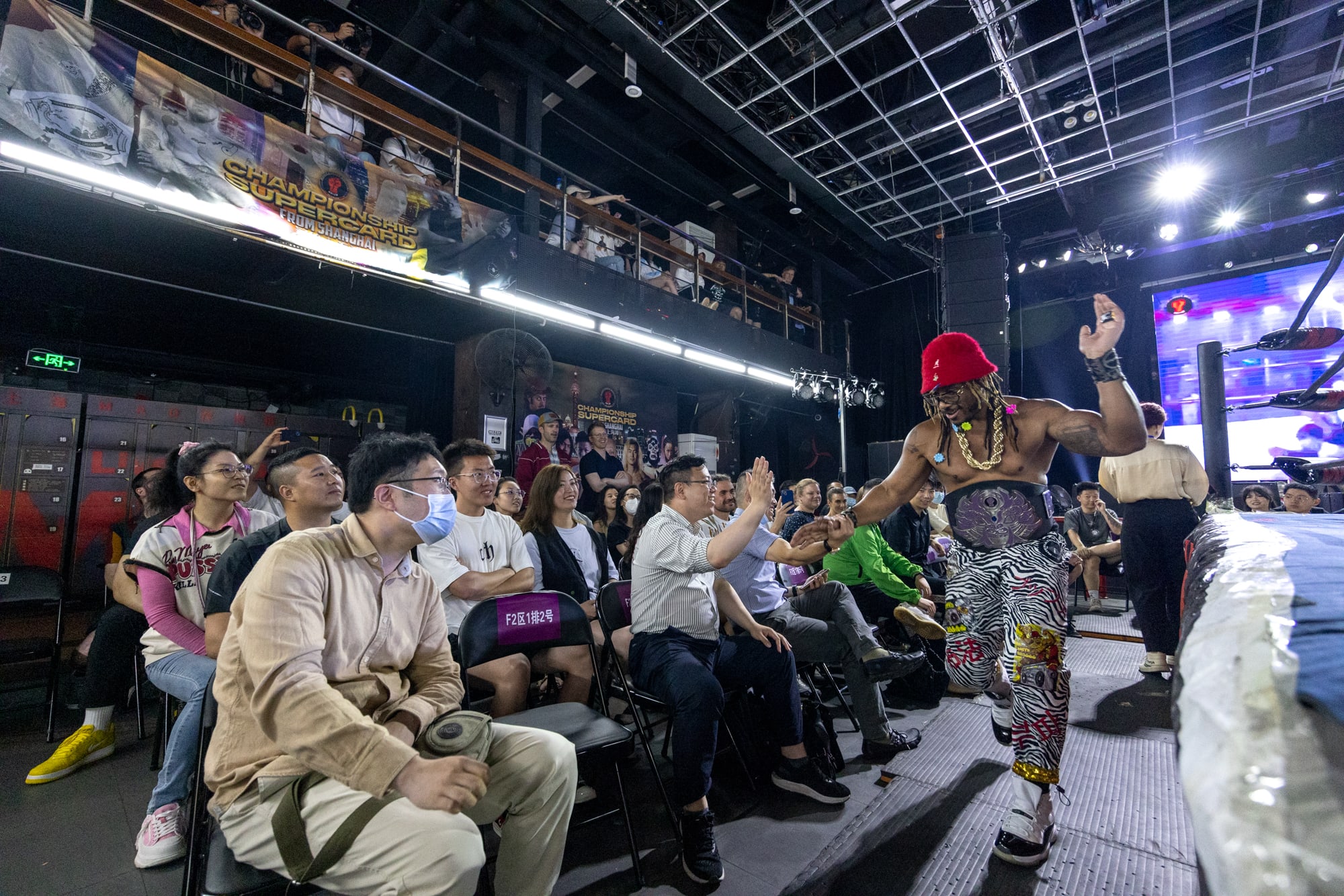
Zhao, only 23, is one of a handful of Chinese wrestlers who aspires for a full-time career in this industry. He began wrestling at 17 years old, when he was a wushu fighter recruited by the rich but doomed Oriental Wrestling Entertainment. For one month, all he did was rolls and bumps. And then his teacher, Cima, put on a demonstration — just two to three moves connected together, Zhao recalls, but enough to make his jaw drop. “I decided right then that even if it takes a lifetime, I have to do this.”
He’s been to Japan five times to wrestle, and says he doesn’t necessarily have to go the route of Tian Bing or Xia Li, who were both signed to WWE via tryouts in Shanghai. He’s thinking long term. “After I’m done here, I hope I can stay in Japan for a few years, and then maybe America. The more in-ring experience you accumulate, the more exposure you’ll have, the more people you’ll know, and then the more people will find you — and the more companies you can work for.”
His tag-team partner, Wang Xinxuan, is also an OWE alum. Wang had his first match at age 18 and dropped out of school to wrestle full time, but it hasn’t exactly worked out. After OWE folded, there wasn’t enough money in other domestic promotions to sustain a living. He does sales at a nightclub to pay the bills.
Wang, who wrestles as The Freaking Wong in singles competition, exudes charisma and is only 25, but he calls himself old. His self-deprecation blends with a sense of pragmatism. He says he has no shot at the WWE. “It values size and strength. Look at me.” As for the development of Chinese wrestling? “It still has a long way to go. A long way.” But he adds, “If there’s an opportunity for me abroad, I’ll take it. And if there’s anything I can help with in China wrestling, I’ll help.”

The penultimate match is a six-man tag pitting Ho Ho Lun, Yoshi Tatsu, and Zombie Dragon against Big Sam, Uncle Money, and Bitman, making up The Stable, managed by Chairman Al (who behind the scenes is MKW partner Alan Tse) and Queen Marie. It’s a star-studded affair: Yoshi Tatsu was in the WWE system for seven years and is currently signed to All Japan Pro Wrestling. Big Sam, who is six-foot-four-inch, 275-pound Sam Burgess, trained in Wales as a teenager and has been one of China’s most consistent foreign draws. Uncle Money (Tre’ Williams) has muscles on top of muscles, and all night seems to jockey with Big Sam to see who can be a more prickish heel.
It’s a true showcase of professional wrestling, with posing (mostly Big Sam and Uncle Money standing over Ho Ho Lun), posturing (from everybody), and outside interference (from Queen Marie, who Zombie Dragon “blinds” by spitting a mouthful of his signature green mist). There is also humor, since wrestling is supposed to be fun. Ho Ho Lun, while in a chin lock, says through a grimace at someone in the front row, “Don’t laugh.” Everyone laughs.



When Big Sam hurls Zombie Dragon across the ring, two girls in the audience, who have been standing the entire time, shoot each other astonished looks. Uncle Money tags in and does his thing: entertains. He does push-ups with the crowd counting along but stops at eight. “That’s all ya’ll get. You don’t deserve 10.” When they boo, he snaps, “Fuck all y’all. You’re trash.”
Eventually, Zombie Dragon tags in Yoshi. It’s a hot one. With the crowd chanting his name, Yoshi executes a spinning heel kick on Uncle Money off the top rope. He takes Big Sam to the ground and locks in a submission while Ho Ho Lun does the same to Bitman. Zombie Dragon flies off another turnbuckle to deliver a leg drop on Uncle Money. There is a simultaneous pinfall and tap-out for the good guys. It’s a crowd-pleasing finish, prompting a slow, bitter exit from the heels.
The whole thing was especially rewarding for Queen Marie — Mariia Kharitonova in real life, a trader and fashion entrepreneur. She helped secure the venue for the Shanghai show, pushing MAO Livehouse to honor its agreements from the previous year, and then promoted the heck out of it, helping it sell out 10 days in advance. “The preparation had become part of my life,” she says.
She feels “more than optimistic” about the future of Chinese wrestling. “I believe in success because what we did in Shanghai is proof that we did everything right,” she says. “And now we can see the result of that hard work.”

The Slam walks out for the main event carrying a baseball bat and wearing black elbow pads and gloves, à la Goldberg. His opponent, Coldray, on the other hand, is colorful and flamboyant. This is wrestling booking 101: exploit contrasts. Good vs. bad. Outgoing vs. aloof. Smiling vs. sneering. The problem, however, is something that the veteran wrestlers — Zombie Dragon, Big Sam, the entire Hong Kong contingent — have alluded to: There is a lack of ring psychology, a logical progression from bell to bell. Are stories being told between the ropes, or are the wrestlers just setting up spots? The crowd can’t figure it out, either. “Coldray must be the good guy because he’s wearing pants,” someone quips.
For the record, The Slam is the face. But it is indeed a spot-fest. Multiple tables are broken, ringside weapons are wielded. A “holy shit” chant breaks out, which is good. The Slam tombstone pile-drives Coldray on the outside, then rolls Coldray into the ring…for a two count. In the end, Coldray retains his MKW championship.

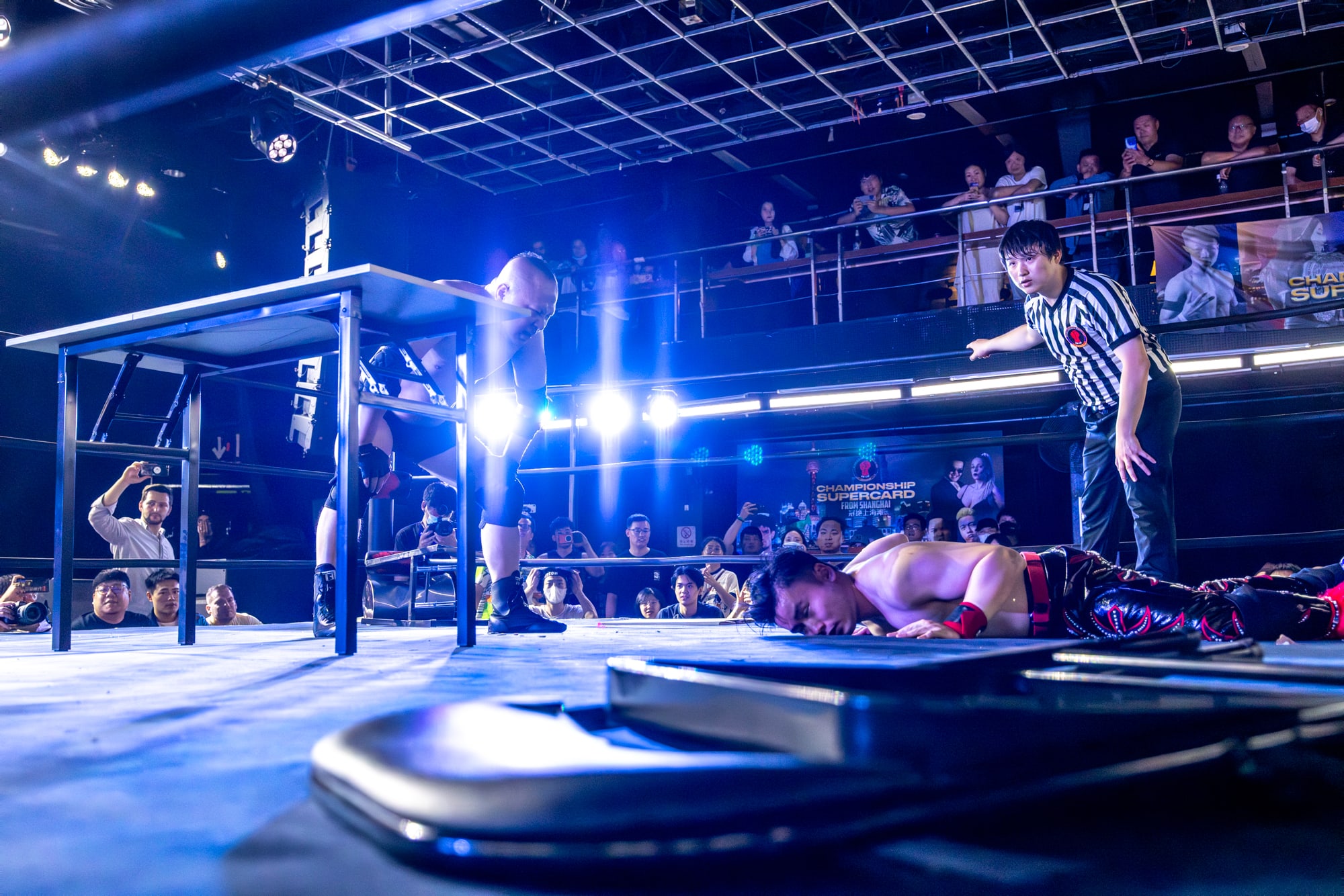
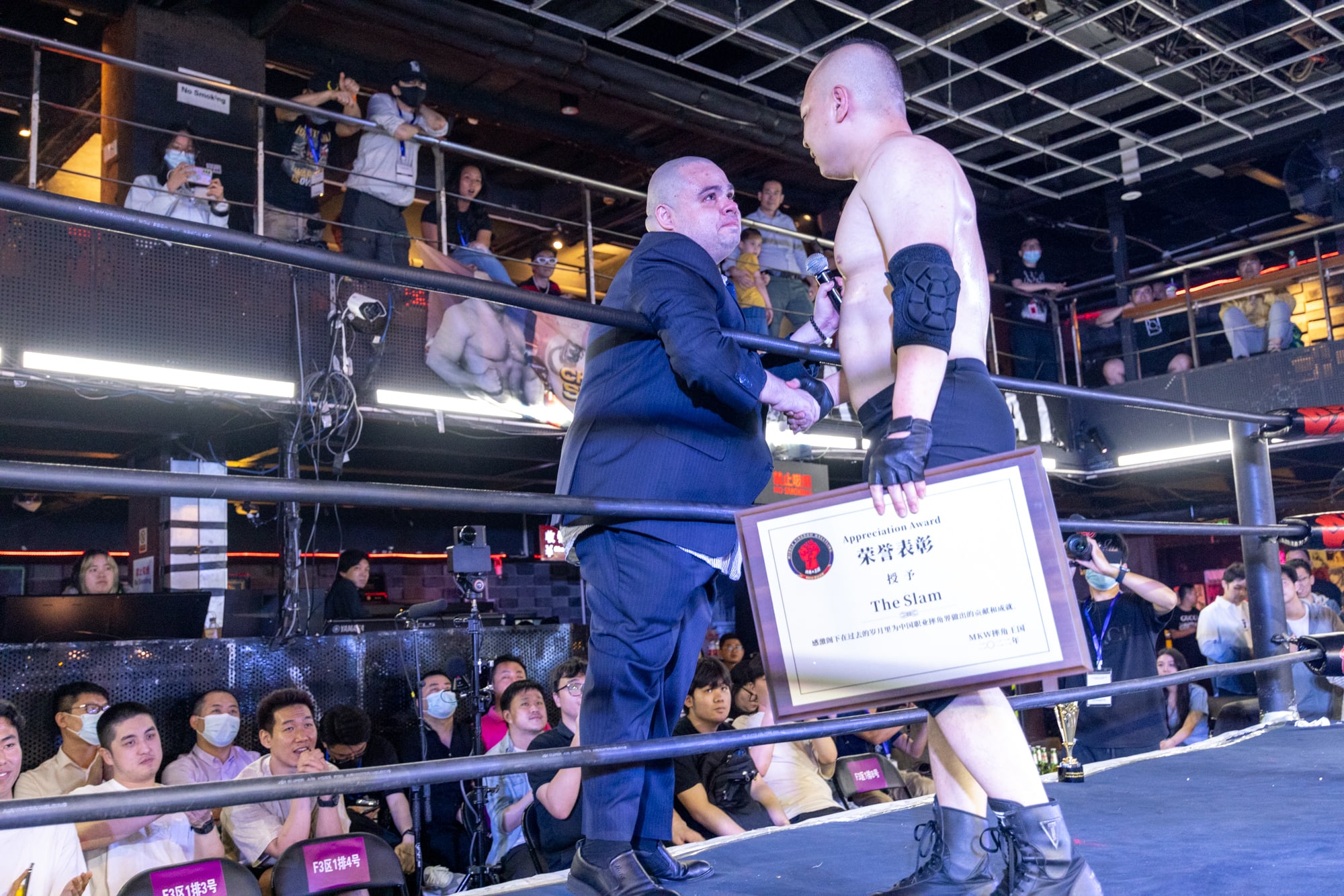
As he’s cutting a promo, saying he’ll be a champ forever, M.A.’s music — Metro Boomin’s “Superhero” — hits. This is MKW’s version of a Money in the Bank moment, but the crowd doesn’t quite get what’s happening. The emcee steps on the suspense when he says into the microphone, “Looks like we have a special impromptu match here, ladies and gentlemen.” Gomez is visibly frustrated, and snatches the mic from his emcee to clarify that, as the promoter, he is the one authorizing this championship bout.
One would think M.A. is wrestling babyface, but he does a heel maneuver by pulling Coldray’s shoulders up from the mat to stop a pincount, in order to beat him up some more. M.A. gets the pinfall after a clothesline from hell, and we have a new champ.
Afterward, in the back, wearing a customized No. 21 Kansas City Chiefs jersey, M.A. looks as nonchalant as ever. At my behest, he explains his fascination with the Chiefs and Patrick Mahomes.
Wrestling’s future in China rests on the shoulders of people like M.A., who trained under The Slam and has since wrestled in Japan five times. “I think it’ll be hard,” M.A. says about China wrestling’s prospects, “but I guess I’m still optimistic. COVID is over, so things have to get better. It’ll be better than in the past, and there’ll eventually come a time when it’ll be developed. I just can’t say how long it’ll be, or how it’ll happen. We’re all in this together, and we’re all working hard to create this.”
The MKW Championship Supercard from Shanghai may have been a reunion, a comeback show, and a celebration, but there is also the sense that it was a hard restart, a return to the beginning of a road that had already been partway trodden, one that remains as long and treacherous as ever.
Gomez and MKW are preparing for their next show in Shenzhen, in December. The plan is to do two big live shows per year but make money through partnerships, such as with streaming companies. It recently signed a deal with Premier Streaming Network, which will host its video library plus future content. “I want people who are huge wrestling fans like myself to make a living from wrestling,” Gomez says. “Doing what you want to do, and being able to support yourself, your family, and not having to look at wrestling as a sacrifice.”
Alan Tse, the MKW partner, sees the pre-COVID times as a golden era for Chinese wrestling, one that was short-lived because of reckless spending. Now there will have to be more prudence. He notes that before the pandemic, Ryan Chen and Gomez — KOPW and MKW — might have seen each other as rivals, but now they’re partners. They’ll share wrestlers and probably ideas, too. “We really, really need a lot of effort together to make this happen,” Tse says.
Chen agrees. “The more people in China wrestling, the better. China is very big. If every city could have its own promotion, then it’ll be simpler for all of us to hold events.”
Meanwhile, M.A. will defend his newly won title in December. Black Dragon will face an unnamed challenger in August. Buffa is laying the groundwork for his own promotion in Shenzhen. Ho Ho Lun is back in Japan, preparing for Dragongate’s biggest show of the year this Sunday in Kobe. Coldray, MKW’s head trainer, works with students every Sunday at Animal MMA in Shanghai. And The Slam is still grappling in Dongguan, still keeping CWE alive. “It’s not a matter of doing or not doing,” he says. “As long as I’m here, I can run a show anytime, I can recruit wrestlers anytime.” He may be China’s first wrestler, but he won’t be its last.

